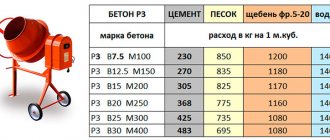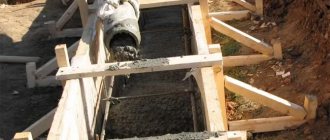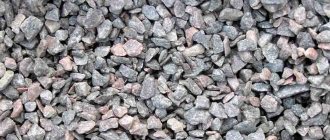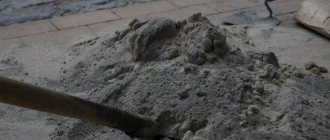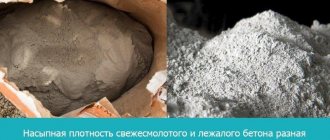Cement consumption per 1 cubic meter of concrete is a very important parameter that you need to be able to determine yourself and calculate before purchasing materials and starting repair and construction work. After all, the technical characteristics and properties of the concrete solution and the poured structure/building will directly depend on the quality and correct calculation of the amount of cement.
In a concrete solution, cement is the main and most important component that connects all the others. In addition, its cost is the highest. That is, the component cannot be saved, since due to insufficient cement in proportion, the solution will be of poor quality and will lose its strength characteristics and resistance to various influences.
But excessive consumption of cement also does not have a good effect on the result - it significantly increases costs and makes the solution unsuitable for work. The calculation of cement per cube of concrete must be accurate, since when the mixture is oversaturated with powder, the reverse process begins, the water evaporates faster and the monolith loses strength and becomes covered with cracks.
You can calculate cement per cube of concrete in volumes (buckets, other containers), kilograms, 50 kg bags, etc. In regulatory documents, proportions are usually indicated in volumetric parts or weight.
How to correctly calculate how many bags of cement are needed per 1 cubic meter
If there is not enough binding element in the composition, then it will be too fragile, will not be able to bind all the components and will quickly collapse under the influence of external factors. Therefore, it is necessary to accurately calculate the number of all parts.
It is not recommended to purchase material in reserve. Extra bags can put a significant dent in your budget. It has a limited shelf life, after which it loses its properties. That is why it is necessary to correctly calculate how much cement is needed for a cube of mortar.
Most often, one part of binder material is used, three of sand, five of crushed stone. It turns out that there are nine elements per cubic meter. Then, the cubic meter is converted into centimeters, then divided into parts. It turns out to be 111111 centimeters.
The weight of the connecting element is 3 g/cm3. By multiplying the specific gravity by the quantity, you can find out the final weight. It turns out - 333333 grams, that is, 333.333 kg. The standard bag weight is fifty kg, that is, a cubic meter of concrete mixture requires six and a half bags of cement .
This is an approximate calculation for M100, which is used when pouring under the foundation. The same calculation is suitable to find out how much concrete should be for the screed.
| Cement consumption per 1m3 of concrete mortar | |||||
| Concrete grade | |||||
| M75 | M100 | M150 | M200 | ||
| Cement brand | M400 | 195 kg | 250 kg | 345 kg | 445 kg |
| M500 | 155 kg | 200 kg | 275 kg | 355 kg | |
Recommendations
Problems often arise when making solutions. Cement of a lower grade is brought to the site than is required for the manufacture of a composition of a certain strength class. To achieve the desired effect, its amount increases by 15%. 10% more fine-grained sand is added and this will not affect the quality.
Most often, cement is offered in 50 kg paper bags. This is a convenient container that allows you to quickly calculate its volume to complete the planned work. To do this, calculate how many bags of cement are contained in 1 cube of concrete. To obtain this volume, M300 will require 329/50 = 6.58 bags or 6 bags and 29 kg. This value is multiplied by the volume of solution that is poured. If you need to make a 40 m³ monolith from M300, then you will need 40·6.58=263.2≈264 bags or 13.2 tons. In this case, the quality of the mixture will correspond to the declared parameters, subject to the manufacturing technology.
A correctly calculated amount of cement per cubic meter of mixture will allow you to achieve the desired technical and operational characteristics. We must not forget about the quality of fillers and water. They must comply with the declared parameters and not contain foreign inclusions or impurities. This will help to pre-calculate the financial component and optimize construction costs. When purchasing, it is better to opt for quality brands 400 or 500, since you will need fewer of them at a similar price.
Drawing up proportions
How much sand and cement are in 1 m3 of concrete? 1 part cement + 4 parts crushed stone + 2 parts sand + 0.5 part water. If we convert to kilograms, then to prepare 1 cubic meter of concrete you will need approximately 600 kg of sand.
The correct ratio of all elements makes the solution quite durable and practical. Before you purchase all the components, you need to correctly calculate how much material you need: sand, crushed stone and cement. You can use a ready-made table that will help you calculate the quantity.
Table of proportions of consumption of concrete components per 1 m3 of mixture based on Portland cement M400
| Components of concrete mortar | Brand of concrete mortar | |||||
| M100 | M200 | M300 | M400 | M500 | M600 | |
| Cement, kg | 183 | 263 | 338 | 444 | 500 | 533 |
| Sand, kg | 842 | 738 | 642 | 533 | 500 | 480 |
| Crushed stone, kg | 1282 | 1265 | 1250 | 1200 | 1150 | 1120 |
| Water, l | 92 | 131 | 170 | 222 | 250 | 266 |
| Proportions C:P:SH:H | 1:4,5:7:0,5 | 1:2,8:4,8:0,5 | 1:1,9:3,7:0,5 | 1:1,2:2,7:05 | 1:1:2,3:0,5 | 1:0,9:2,1:0,5 |
Using this ratio, the volume can be calculated. For example, to obtain a cubic meter of raw material M150, mix the parts in a ratio of 1: 3: 5: 0.5. The proportions 1:4:5.5:0.5 are suitable when creating a product with a hundredth class.
Thus, to produce concrete of various grades using Portland cement M400, the ratio of sand and crushed stone per unit of cement will be:
| Components | Concrete grade | |||||
| M100 | M200 | M300 | M400 | M500 | M600 | |
| Cement, kg | 183 | 263 | 338 | 444 | 500 | 533 |
| Sand, kg | 842 | 738 | 642 | 533 | 500 | 480 |
| Crushed stone, kg | 1282 | 1265 | 1250 | 1200 | 1150 | 1120 |
| Water, l | 92 | 131 | 170 | 222 | 250 | 266 |
| Proportions C:P:SH:H | 1:4,5: 7:0,5 | 1:2,8: 4,8:0,5 | 1:1,9: 3,7:0,5 | 1:1,2: 2,7:05 | 1:1: 2,3:0,5 | 1:0,9: 2,1:0,5 |
When using M500 cement, the ratios will be as follows:
| Components | Concrete grade | |||||
| M100 | M200 | M300 | M400 | M500 | M600 | |
| Cement, kg | 155 | 226 | 292 | 380 | 452 | 533 |
| Sand, kg | 903 | 792 | 702 | 609 | 543 | 533 |
| Crushed stone, kg | 1262 | 1267 | 1258 | 1219 | 1177 | 1226 |
| Water, l | 78 | 113 | 146 | 190 | 226 | 266 |
| Proportions C: P:SH:H | 1:5,8: 8,1:0,5 | 1:3,5: 5,6:0,5 | 1:2,4: 4,3:0,5 | 1:1,6: 3,2:0,5 | 1:1,2: 2,6:0,5 | 1:1: 2,3:0,5 |
The solution is mixed in 9 parts, in proportions 1:3:5, where 1 is cement, 3 is sand, 5 is crushed stone. Professionals in the construction and renovation industry advise measuring the volume of components used in parts.
Sand adds plasticity to the composition and fills all voids. Therefore, it is worth following the cooking plan. It is not very high, so you can buy it for future use. Also important is the absence of clay. This may reduce persistence.
It is better to take crushed stone of different fractions. This will help to obtain a strong solution with good waterproof properties. In this way, it is possible to achieve complete filling of voids, which will increase the durability of the structure.
The less moisture there is in concrete, the more difficult it is to lay and compact it efficiently. But this way the monolithic structure turns out to be more durable. A large amount of water makes the composition plastic and easy to pour, but the strength of the concrete will be somewhat reduced.
| Plasticity of concrete | Water consumption, l/m3 | |||||||
| Gravel, mm | Crushed stone, mm | |||||||
| 10 | 20 | 40 | 80 | 10 | 20 | 40 | 80 | |
| Plastic | 220 | 205 | 190 | 175 | 235 | 220 | 205 | 190 |
| Average ductility | 210 | 195 | 180 | 165 | 225 | 210 | 195 | 180 |
| Low plasticity | 200 | 185 | 170 | 155 | 215 | 200 | 185 | 170 |
| Non-plastic | 190 | 175 | 160 | 145 | 205 | 190 | 175 | 160 |
Video instruction: Mixing by hand
Video instruction: Mixing in a concrete mixer
What does consumption depend on?
The amount of cement added per cubic meter. meter of concrete depends on the brand of the required mixture, which is taken into account at the stage of calculating the load on the structure.
To select the proportions of the binder, you need to take into account the mixing conditions, humidity and air temperature when the solution hardens.
When calculating quantities you need to know:
- Quality and moisture content of fine filler. For the solution, clean sand without foreign impurities is used. If the material is dirty with silt and stone inclusions, the binder consumption is increased by 10-15%.
- The grade of powder for preparing concrete must be at least M300. When using a less active dry substance, cement consumption increases by 15-30% per cubic meter. meter.
- Date of manufacture and storage conditions of the dry substance. The shelf life is 6 months, after which the active properties are partially lost and when preparing solutions the rate is increased by 10-20%.
- The required strength, mobility and water resistance of the poured structure. The higher the indicators, the more active substance is needed.
- Size and uniformity of the crushed stone and gravel fraction. High material parameters due to the formation of voids in the solution increase consumption by 10-15%.
- Application of vibration when pouring a structure. If available, it is permissible to mix a heavier solution that requires less dry matter. In the absence of compaction equipment, the solution is made more plastic, increasing the binder consumption by 10%.
Important! It is recommended to use clean and soft water for kneading. The presence of metals and salts in the composition negatively affects the plasticity of the finished mixture.
Do additives affect consumption?
Special plasticizers do not reduce the amount of binder in the solution, but improve the characteristics of the composition. Their use gives concrete properties that are necessary for the object and mixing conditions.
Classification of additives used for concrete:
- plasticizing agents provide the necessary plasticity to the solution;
- accelerators reduce the hardening time of the poured structure;
- retarders increase the hardening time;
- additives to increase strength characteristics;
- water-repellent give the structure additional protection from moisture;
- frost-resistant allow the structure to be poured at sub-zero temperatures;
- expanding make the composition lighter;
- self-compacting ones allow thin-walled structures to be poured without loss of strength.
Special compositions regulate the humidity in the structure being poured and impart special properties that help perform work with materials that do not comply with GOST or under unfavorable weather conditions.
Consumption per 1m3
Before purchasing building materials, keep in mind that:
the error in cement calculation can be up to one kg;
other elements - no more than five;
to get a high-strength option, you need to take a material with an indicator twice as high;
for domestic construction you can use a substance of the same class;
water is added in small portions during mixing.
The specific number of parts depends on the composition requirements. The consumption of creating the M100 will be about two hundred twenty-five kilograms per cubic meter. To get an M150, they take two hundred and sixty-five kg; to get a two hundredth, they take three hundred and fifty kg.
The volume of water depends on the requirements for the finished product. When mixing M200 the ratio will be 0.5. That is, every two kilograms require one liter. The hundredth solution is 0.6-0.8. You should not take more, as this will increase the hardening time and significantly reduce the strength and frost resistance. The liquid that has not reacted will evaporate, resulting in the formation of pores in the structure.
| Consumption of masonry mixture per 1 m3 of brickwork | ||||||
| Wall thickness in bricks | ||||||
| 0.5 (12 cm) | 1 (25 cm) | 1.5 (38 cm) | 2 (51 cm) | 2.5 (64 cm) | ||
| Type of brick | Regular (25x12x6.5 cm) | 0.189 m3 | 0.221 m3 | 0.234 m3 | 0.240 m3 | 0.245 m3 |
| Modulated (25x12x8.8 cm) | 0.160 m3 | 0.200 m3 | 0.216 m3 | 0.222 m3 | 0.227 m3 | |
Calculation of concrete consumption for a slab foundation
A slab foundation is a monolithic concrete slab that is poured under the area of the construction site.
Tile foundation
When calculating the consumption of materials for concrete in this case, three parameters must be taken into account:
- pouring area;
- slab thickness (at least 10 cm);
- volume of stiffeners.
If we take as an example the same room with an area of 10 by 10 m, then the calculations will look like this:
- Slab area: 10 x 10 = 100 sq.m.
- Slab volume: 100 x 0.1 (slab thickness) = 10 m3. For a structure with dimensions of 10 by 10 m, 8 stiffeners will be required. 4 along and 4 across every 2.5 m. The thickness of the ribs is equal to the thickness of the slab - 0.1 m. The total length of the ribs will be 8 x 10 = 80 m.
- Ribs volume: 80 x 0.1 (thickness) x 0.1 (height) = 0.8 m3.
- The general concrete consumption rate for such an object will be: 10 + 0.8 = 10.8 m3.
To pour a slab foundation with a 10 by 10 m area, 10.8 m3 of concrete will be required.
How to find out how much sand, crushed stone and cement you need on the Betonych company website
In order to save time in proportioning the number of components, you can use the manufacturer’s website. There is a special concrete calculator that will help you quickly find out how much is required. First of all, choose the type of base for the house. In order to find out the volume of material for the strip version, you need to indicate:
height;
width;
perimeter.
When calculating the foundation slab, you only need to indicate its area. Once the parameters are set, click the “Calculate” button. The system will show the consumption of building materials to create the structure.
The Betonych association’s own production makes it possible to obtain a liquid with excellent strength and frost resistance.
All components are thoroughly tested to ensure their excellent quality. The product was created taking into account all requirements and has a quality certificate that confirms this. Specialists can prepare according to the customer’s recipe.
Concrete for the foundation is transported in accordance with all standards and requirements. This allows you to maintain its rigidity, uniformity, and mobility. Delivery to any city in the country allows you to buy a high-quality mixture at the manufacturer’s cost.
To make sure that buying finished products is much easier than counting the number of elements yourself and mixing everything, you can order a small volume. This will allow you to evaluate the advantages of this method.
Placing an order is very simple: you just need to leave a request and agree on all the details with the manager. The specialist will tell you in detail about all the properties of the material, help you decide how much cement is needed for 1 cubic meter of concrete, and select the best delivery method.
How much cement is needed depending on the type of concrete
Cement should be purchased with an indicator on the package twice as large as the solution required. If you need a mixture of the M200 brand, then the bag of dry matter should be marked M300-400.
M200
Used for screeding floors, strengthening existing structures and filling garden paths. M200 is not used for foundation construction. The calculation is made using a calculator: the fill height is multiplied by sq. meters of area.
To obtain the solution, you need the M300 grade of cement in an amount of 200 kg.
M300
It is used for pouring foundations during the construction of private sector houses, bathhouses, garages and outbuildings. To prepare the M300 solution, use the M400 brand of binder in an amount of 300 kg per cubic meter.
M400
It is used for the construction of foundations of houses and cottages using a reinforcement frame. This enhances the strength of the structure and allows the construction of multi-story buildings. The brand has good characteristics for performing foundation work during construction.
For 1 cu. a meter of M400 solution will require 300 kg of M400 binder or 350 kg of M300.
Important! When purchasing material, pay attention to the date of manufacture and the flowability of the dry substance in the bag. The period should not exceed 6 months, the packaging must be undamaged and the humidity must be normal, otherwise the consumption of cement to obtain a high-quality mixture will increase by 20%.
Summarize
- When producing concrete, it is necessary to strictly adhere to the required quantity of its components.
- When calculating the amount of cement for making concrete, you must adhere to certain rules.
- When calculating the required amount of cement, for easier calculation, it is recommended to use bags packed in 50 kilograms.
- To make concrete, you must use clean components.
- To make concrete, it is necessary to use cement , the grade of which is several times higher than the required grade of concrete.
Requirements for the components of the composition
Components for the production of concrete must meet the following requirements:
- Materials for making concrete must be clean and free of organic and chemical particles.
- Cement is one of the important components of concrete; it must be no lower than grade M 400. For concrete grade M350, cement must be no lower than grade M 500.
- Crushed stone is also one of the main components of concrete ; its strength should be several times higher than the strength of concrete after the maturation period (28 days). It is recommended to use crushed stone for manufacturing, which has a strength of 800–1000 kgf/sq. cm, this indicator will make it possible to produce concrete grade M450. You can also use crushed limestone, but up to a maximum of M300 concrete grade.
- Sand for making concrete can be used from rivers or quarries, but it must be washed to remove clay and dust impurities. As a rule, fine and medium-grained sand is used to make concrete.
It is not recommended to produce various chemical additives at home when making concrete, as this will lead to a loss of its quality.
